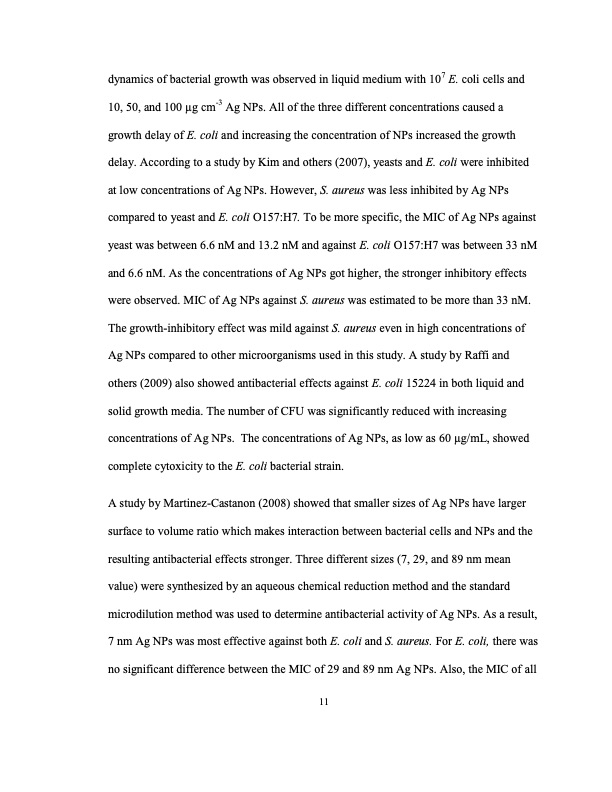
PDF Publication Title:
Text from PDF Page: 022
dynamics of bacterial growth was observed in liquid medium with 107 E. coli cells and 10, 50, and 100 μg cm-3 Ag NPs. All of the three different concentrations caused a growth delay of E. coli and increasing the concentration of NPs increased the growth delay. According to a study by Kim and others (2007), yeasts and E. coli were inhibited at low concentrations of Ag NPs. However, S. aureus was less inhibited by Ag NPs compared to yeast and E. coli O157:H7. To be more specific, the MIC of Ag NPs against yeast was between 6.6 nM and 13.2 nM and against E. coli O157:H7 was between 33 nM and 6.6 nM. As the concentrations of Ag NPs got higher, the stronger inhibitory effects were observed. MIC of Ag NPs against S. aureus was estimated to be more than 33 nM. The growth-inhibitory effect was mild against S. aureus even in high concentrations of Ag NPs compared to other microorganisms used in this study. A study by Raffi and others (2009) also showed antibacterial effects against E. coli 15224 in both liquid and solid growth media. The number of CFU was significantly reduced with increasing concentrations of Ag NPs. The concentrations of Ag NPs, as low as 60 μg/mL, showed complete cytoxicity to the E. coli bacterial strain. A study by Martinez-Castanon (2008) showed that smaller sizes of Ag NPs have larger surface to volume ratio which makes interaction between bacterial cells and NPs and the resulting antibacterial effects stronger. Three different sizes (7, 29, and 89 nm mean value) were synthesized by an aqueous chemical reduction method and the standard microdilution method was used to determine antibacterial activity of Ag NPs. As a result, 7 nm Ag NPs was most effective against both E. coli and S. aureus. For E. coli, there was no significant difference between the MIC of 29 and 89 nm Ag NPs. Also, the MIC of all 11PDF Image | ZINC OXIDE AND SILVER NANOPARTICLES ON INTESTINAL BACTERIA

PDF Search Title:
ZINC OXIDE AND SILVER NANOPARTICLES ON INTESTINAL BACTERIAOriginal File Name Searched:
thesis-zinc-oxide-silver-nano.pdfDIY PDF Search: Google It | Yahoo | Bing
Turbine and System Plans CAD CAM: Special for this month, any plans are $10,000 for complete Cad/Cam blueprints. License is for one build. Try before you buy a production license. More Info
Waste Heat Power Technology: Organic Rankine Cycle uses waste heat to make electricity, shaft horsepower and cooling. More Info
All Turbine and System Products: Infinity Turbine ORD systems, turbine generator sets, build plans and more to use your waste heat from 30C to 100C. More Info
CO2 Phase Change Demonstrator: CO2 goes supercritical at 30 C. This is a experimental platform which you can use to demonstrate phase change with low heat. Includes integration area for small CO2 turbine, static generator, and more. This can also be used for a GTL Gas to Liquids experimental platform. More Info
Introducing the Infinity Turbine Products Infinity Turbine develops and builds systems for making power from waste heat. It also is working on innovative strategies for storing, making, and deploying energy. More Info
Need Strategy? Use our Consulting and analyst services Infinity Turbine LLC is pleased to announce its consulting and analyst services. We have worked in the renewable energy industry as a researcher, developing sales and markets, along with may inventions and innovations. More Info
Made in USA with Global Energy Millennial Web Engine These pages were made with the Global Energy Web PDF Engine using Filemaker (Claris) software.
Infinity Turbine Developing Spinning Disc Reactor SDR or Spinning Disc Reactors reduce processing time for liquid production of Silver Nanoparticles.
| CONTACT TEL: 608-238-6001 Email: greg@infinityturbine.com | RSS | AMP |